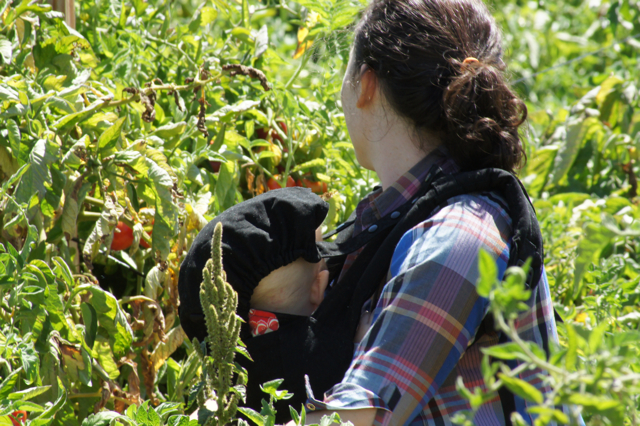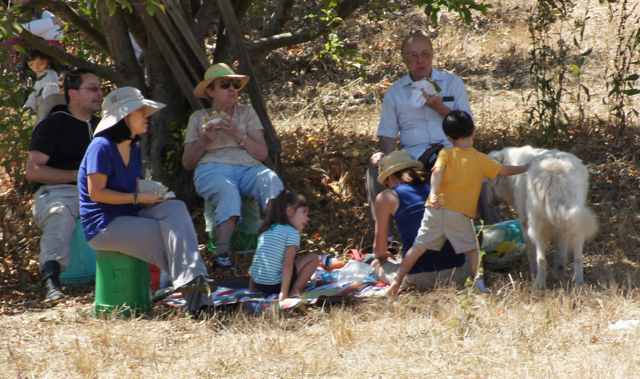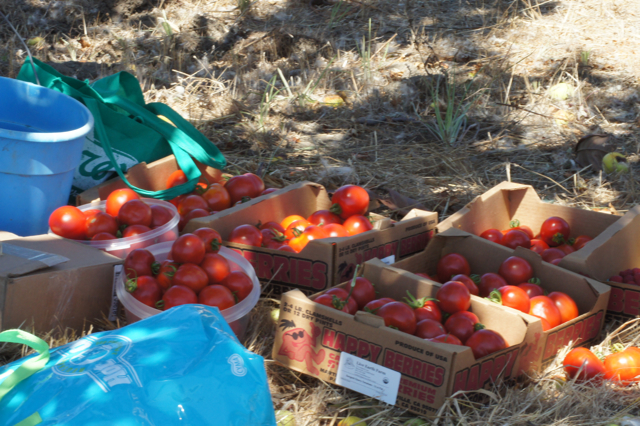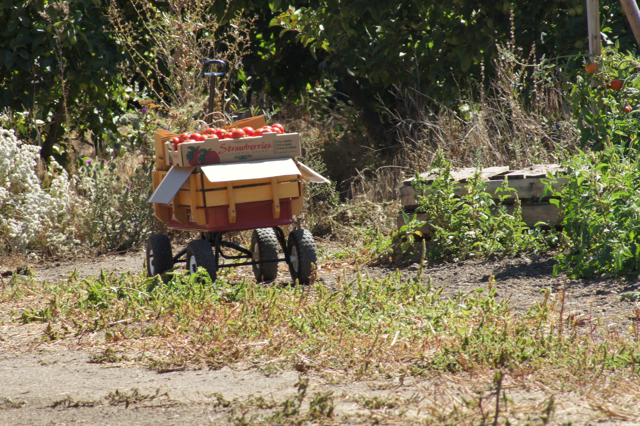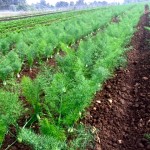 What’s Coming Up in the Fields – May 2016
What’s Coming Up in the Fields – May 2016
April and May are the months when many crops are seeded or transplanted in preparation for the upcoming main season. There are also many crops on the verge of being ready for harvest. Take a walk with us through the fields to see what’s coming up.

Italian Parsely seedlings break up the brown soil with rows of green.

Nearby to the parsely are rows of Fennel, their wispy shoots reaching up toward the sky.
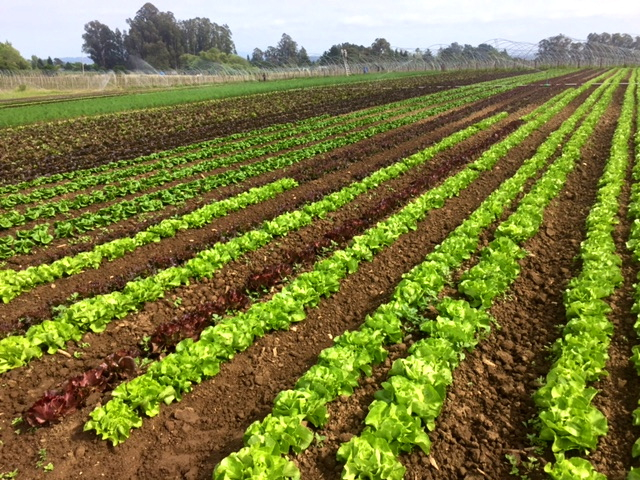
The lettuce crops have been bountiful this spring, and these rows of Green and Red Butter Lettuce are no exception.
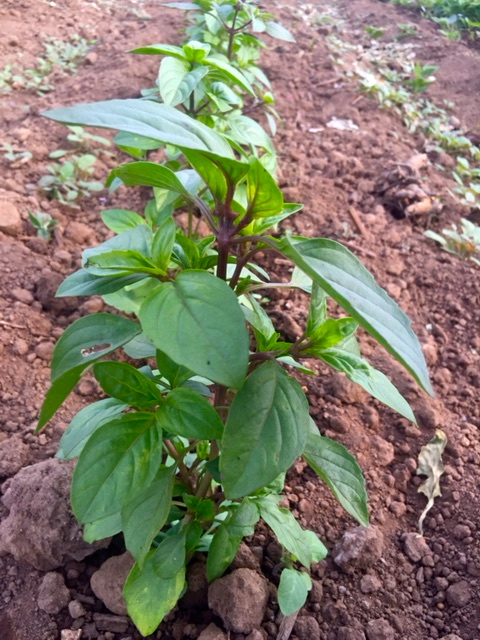
A nice, healthy Basil plant just about ready for harvest.
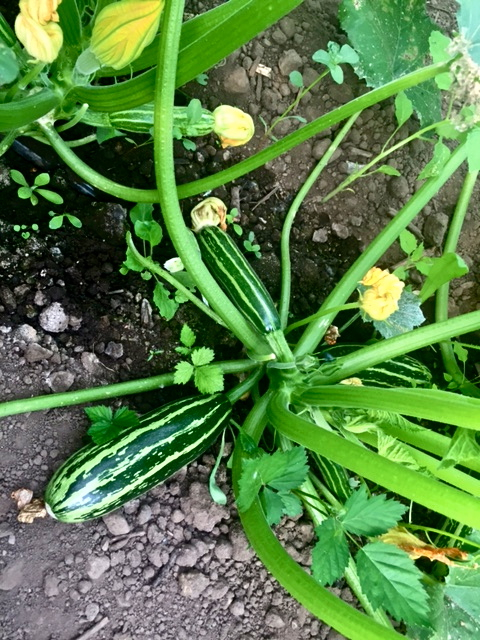
We have three crops of Summer Squash all at various stages. The one pictured here is ready for harvest, so there’ll soon be squash for the shares.
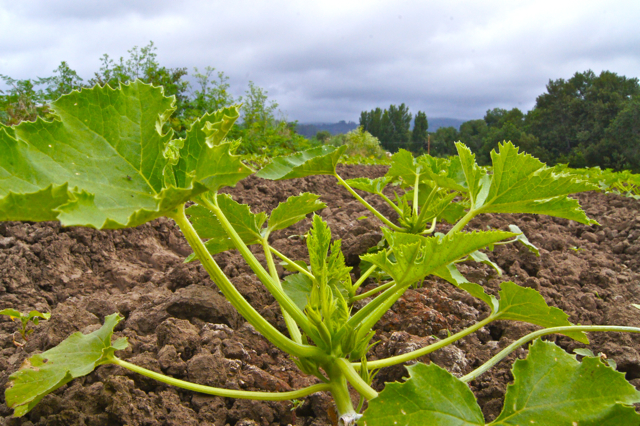
Still small, these are one of the other crops of Summer Squash.
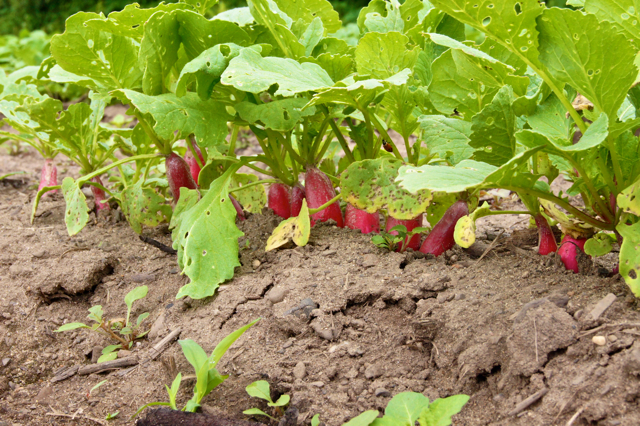
These French Breakfast Radishes are pushing their shoulders up out of the soil, letting us know it’s almost time to harvest them.

The Cucumbers are sizing up, while more blooms means the harvest will continue for a number of weeks.
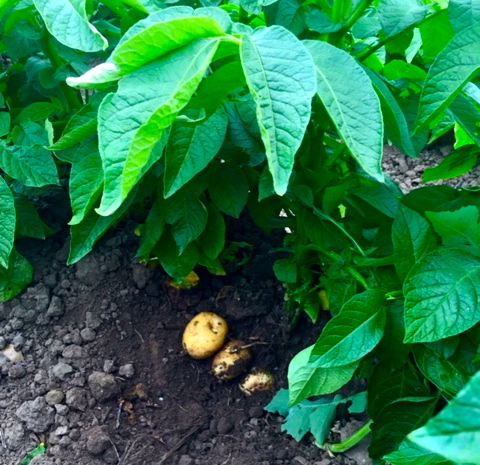
Potatoes – little jewels of the earth – are just a couple of weeks away from being large enough to harvest.
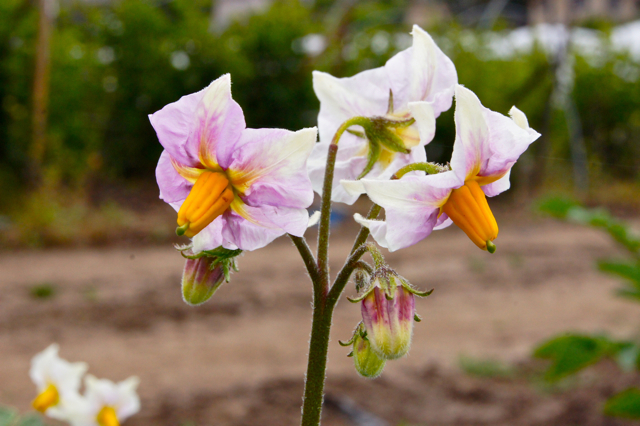
Though potatoes are a root that grows in the ground, the plants also produce lovely blossoms.

A Broccoli head, peeking out from its nest of leaves, will be ready in about two weeks.
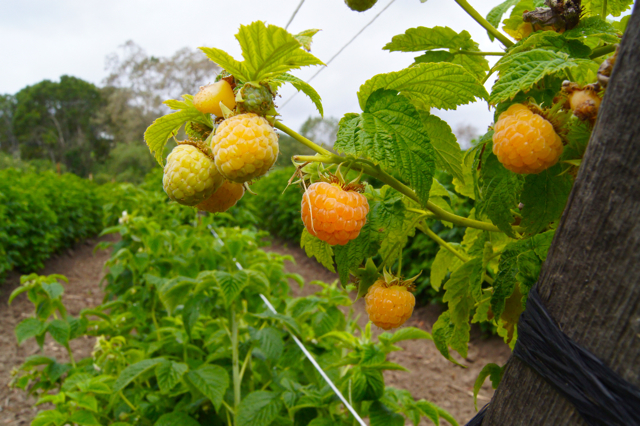
The first Golden Raspberries of the season, these are just a teaser since the rest of the berries are still very green – about three to four weeks away.
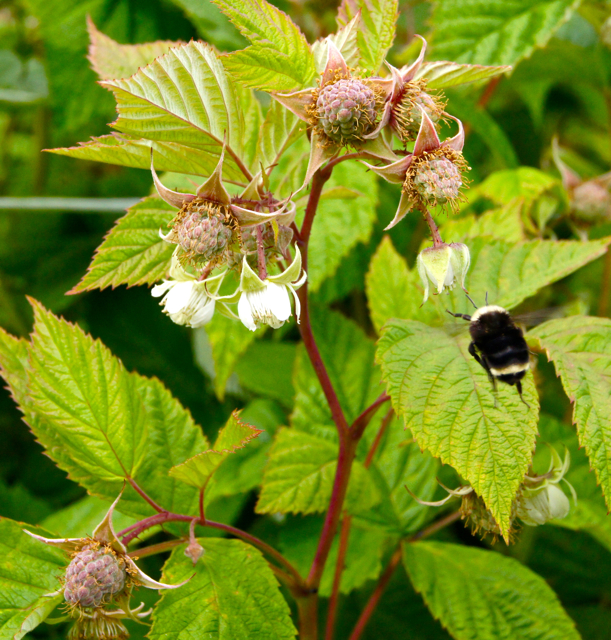
The Red Raspberry vines are loaded this year – all their blossoms have made the bees very happy.
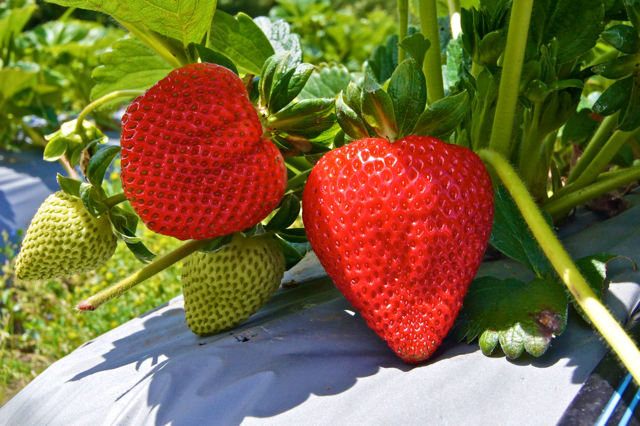
While the raspberries are still weeks away, the Strawberries have been producing for about a month now. We had some initial difficulty with soft spots from the rains, but the plants are sizing up nicely and will be ready for our first U-pick on June 4th.
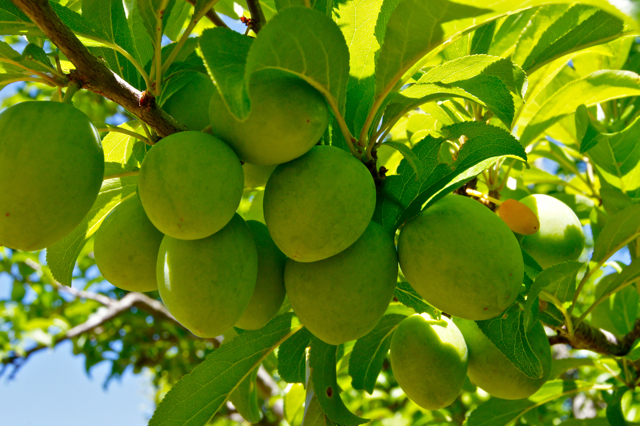
These young Santa Rosa plums will have turned purple and be ready for harvest by mid-June.

Tomato seedlings were transplanted before one of the recent rains. We dry-farm them, so their roots are following the water down into the soil, and their delicious fruit will be ready in about 3 months.
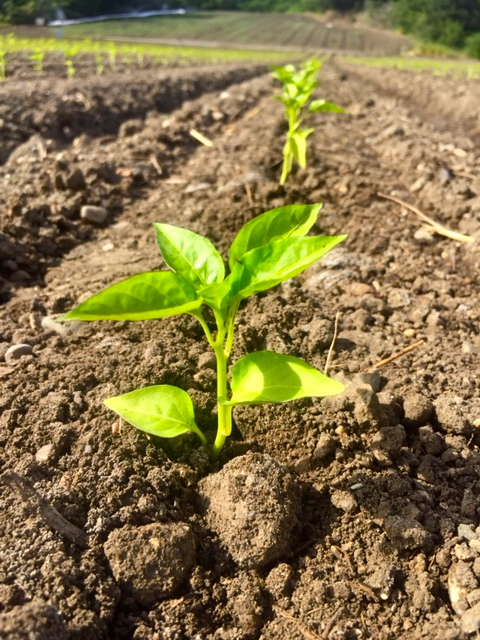
Pepper seedlings are sown at the same time as tomatoes. The first peppers will also be ready around the end of July or beginning of August.
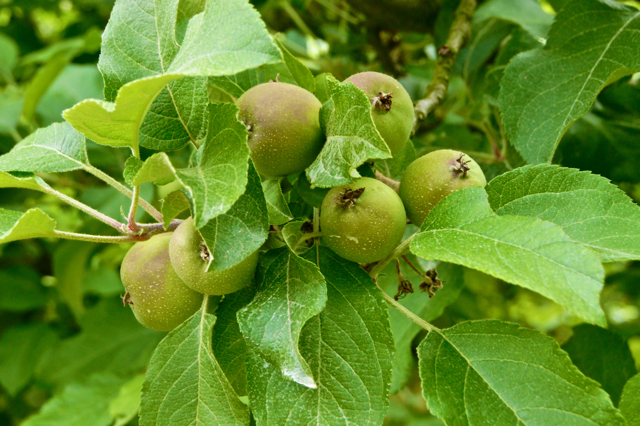
The Apples are ready to be thinned (this cluster will be thinned to just 2 or 3 apples), which helps them reach a decent size. These Fujis won’t be ready until the end of Sept. or beginning of Oct.
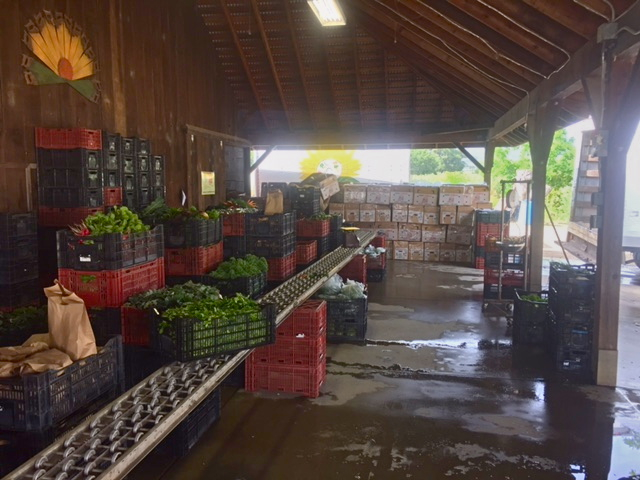
Two days a week, after the harvesting is done, we set up in the barn to pack our CSA Shares full of the goodness the Farm provides.
Thank you for taking this walk with us. We hope to see you on the Farm soon.
 End of Summer
End of Summer
Not much time to sit down, reflect and write – all our energy is focused on keeping up with the pace and intensity of the farm. It is as if Mother Nature is aware that these are the final weeks of summer. 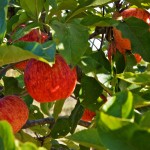 Galas are hanging ripe for the picking. The first block of winter squash (Delicata and Sweet Dumplings) is ready to be harvested. Everything is ripening and there are barely enough hours in the day to keep up with the raspberries, peppers, tomatoes, cucumbers, and summer squash in addition to the usual staple crops of beets, lettuce, broccoli, cauliflower, leeks, and strawberries – to name a few. Now is the time we most feel the support of the team at play, and the smiles on our faces at the end of a 12-13 hour day are a mutual acknowledgement of this joint effort.
Galas are hanging ripe for the picking. The first block of winter squash (Delicata and Sweet Dumplings) is ready to be harvested. Everything is ripening and there are barely enough hours in the day to keep up with the raspberries, peppers, tomatoes, cucumbers, and summer squash in addition to the usual staple crops of beets, lettuce, broccoli, cauliflower, leeks, and strawberries – to name a few. Now is the time we most feel the support of the team at play, and the smiles on our faces at the end of a 12-13 hour day are a mutual acknowledgement of this joint effort.
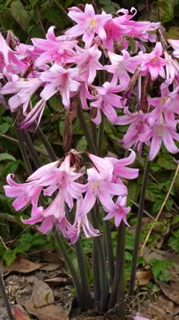 The “Naked Ladies” (Amaryllis belladonna) with their striking pink flowers are in full bloom, which is an early sign that summer is almost over. Knowing that shorter days are just around the corner, we are already preparing the fields and planting our fall and winter crops.
The “Naked Ladies” (Amaryllis belladonna) with their striking pink flowers are in full bloom, which is an early sign that summer is almost over. Knowing that shorter days are just around the corner, we are already preparing the fields and planting our fall and winter crops.
With summer vacations technically over after Labor Day, we invite you to extend that summer feeling a bit longer by joining us for another round of U-pick Community Farm Days the next two Saturdays – August 30th and September 6th.
Bring the kids to explore the farm; we have plenty of activities planned to go along with your harvest adventures – tractor rides, apple cider pressing, and farm walking tours. Now is the best time to pick and preserve the summer bounty to be enjoyed later during fall and winter.
Here on the farm we measure the end of summer when strawberry beds are prepared for planting and we stop picking tomatoes – with the typical extension of our coastal summer weather, the tomato harvest could last into mid-October. Hope to see you here on the farm to join the harvest effort.
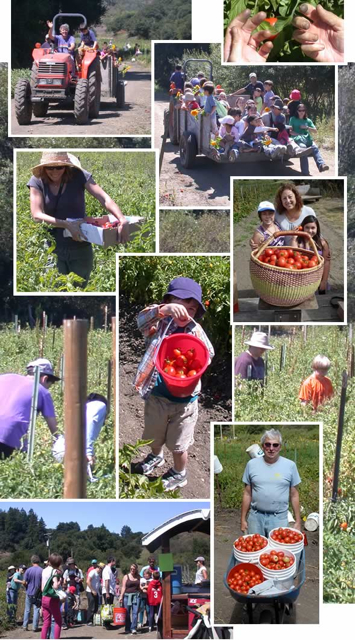
 Field Walk – January 2015
Field Walk – January 2015
The farm’s winter fields are a patchwork of cover crops and winter veggies. Take a walk through them with us and see all the changes. Click on the highlighted text to reach related previous posts.

It seems strange to have to irrigate in January yet there were only a couple of brief rain storms in November and December and none this month, so using groundwater is a must if we’re to have anything to harvest in the coming weeks.
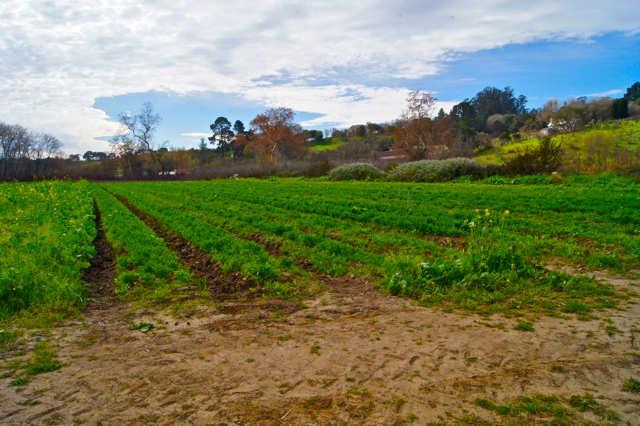
These rows of carrots are where cherry tomatoes were growing just a few months ago. Some of you may remember them from our Tomato U-picks.
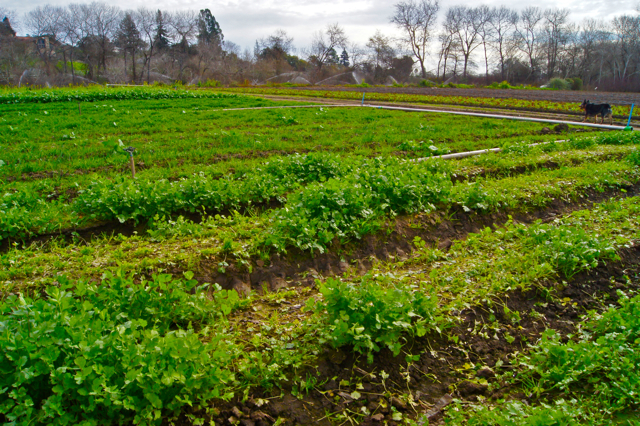
This field was full of pepper plants in the summer, while the field beyond was full of dry-farm tomatoes. Now there are rows of cilantro, onions, carrots, and purple top turnips in the near field, with chard in the one beyond.

Though the fields in the first photo were being irrigated with sprinklers, drip irrigation is becoming more necessary to help conserve precious water.
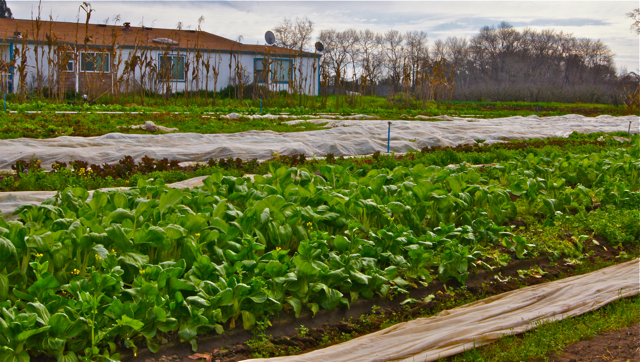
In summer, this field grew a mix of herbs, peppers, and tomatillos. Now it is full of greens, including a variety of pok choi (in the near ground) that made it into some of last week’s shares as a substitute for a couple of other veggies that came up short.

These year-old raspberry canes that were lush and green in summer are getting pruned back.

This was a field of 2-3 year old raspberry canes. They’re gone now, and the rows are full of recently transplanted greens. Some have been covered to protect them from colder night time temperatures.

Berry canes are not the only thing getting pruned this month, so are apple trees like the old Newtown Pippin pictured here.

While some apple trees on the farm grow without guidance others, like the Fujis pictured here, are espaliered – trained to grow along wires that support the weight of the apple crop and make harvesting easier.

Near the trees pictured above are next season’s strawberry fields – the farm plants over 80,000 strawberry starts at the end of the year in preparation for the April-Oct fruiting season.
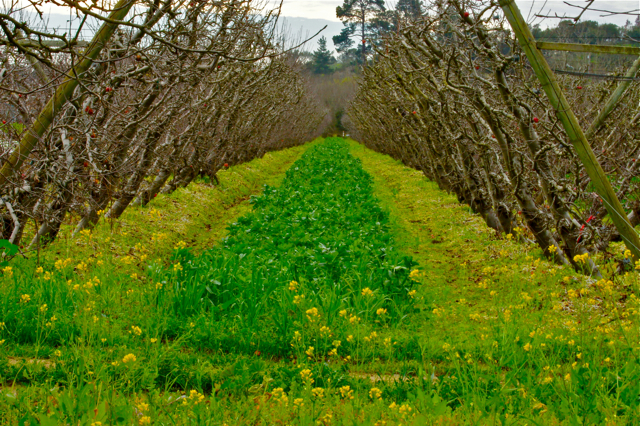
Cover crops are sown in between the rows of these espaliered Royal Gala apple trees. At the end of the crop’s growth cycle, it will be disc-ed in to provide nutrients during the time the apples are growing.

These fields are a patchwork of recently plowed ones, current season rowcrops, and cover crops.
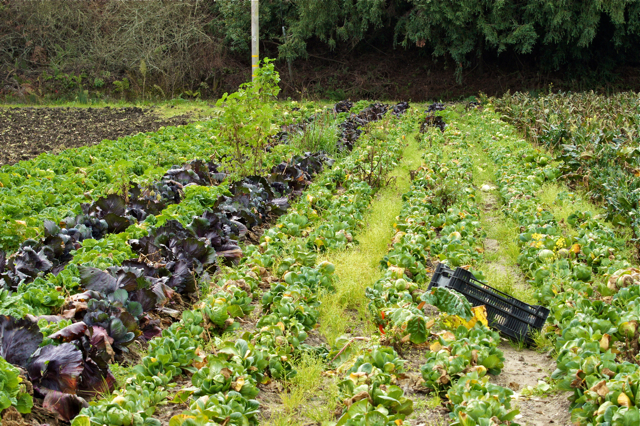
Green and red cabbage tough out the colder weather, slowing their growth (CSA members may have noticed the decrease in size of some items in their shares) and producing sugars, making them sweeter than cabbage grown in the summer season.
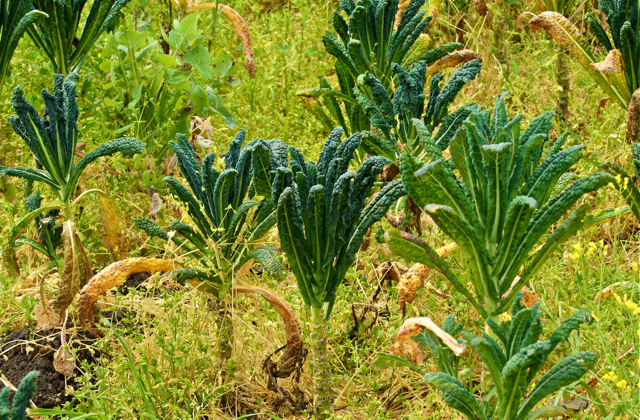
Next to the rows of cabbage are ones of kale. The Lacinato pictured here is being harvested for CSA shares. We leave the plants in the ground, harvesting just the leaves to prolong the life of the crop.

Bolting broccoli plants lend a splash of color and brightness to the muddy brown fields.
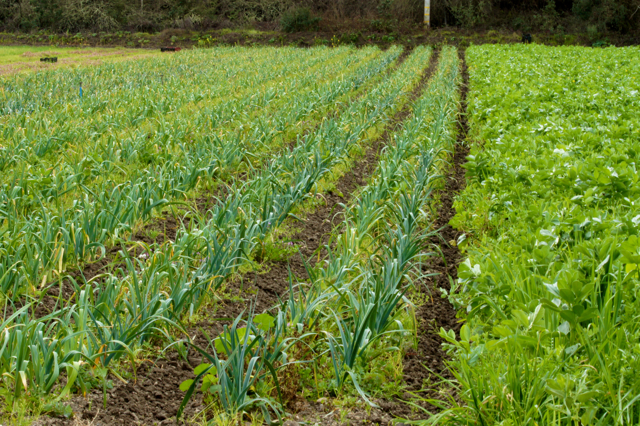
A little further along, rows of green garlic for upcoming shares are bordered on the right by a field of cover crop.

This field of cover crop leads up to an orchard of Newtown Pippin apple trees. This variety of apple was grown extensively in the Pajaro Valley for use in Martinelli’s apple cider.

Windfalls in the orchard provide food for over-wintering birds.

More cover crops are nearby, with rows of raspberry canes beyond (where the white buckets are). The small orchard to the left are apple trees that have been grafted.
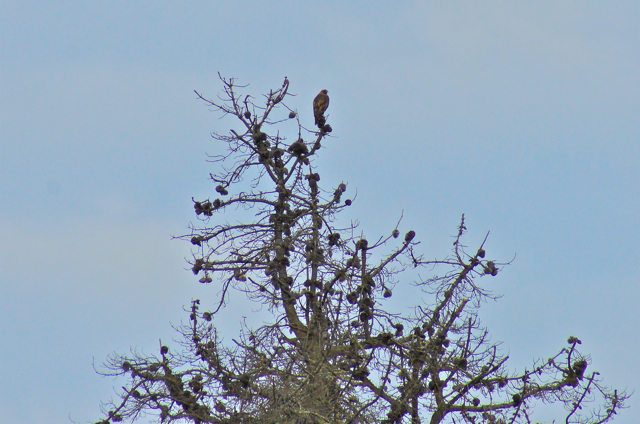
Red-tailed and -shouldered hawks are a common sight at the farm. On gopher patrol, this one is perched high in a dead pine overlooking the fields.
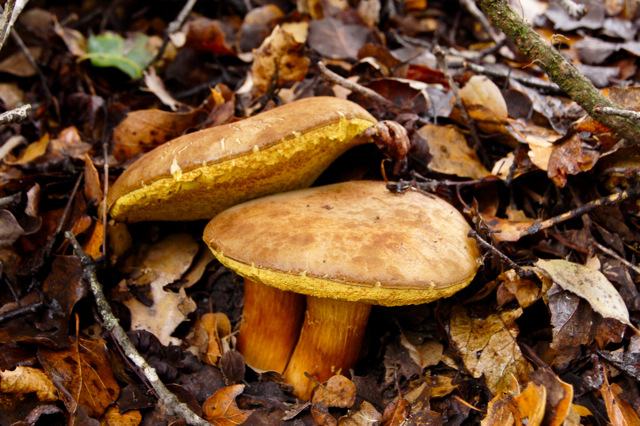
During winter, mushrooms, like these boletes, are common in the wilder sections of the farm.

Recently cultivated and formed rows are ready for transplants.
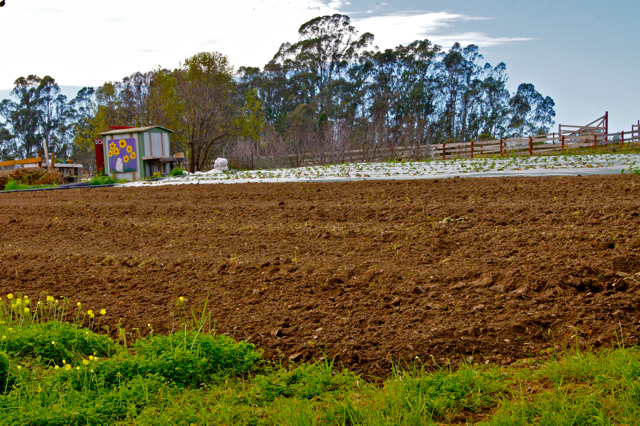
Just like the rest of the farm’s fields, the Farm Discovery fields are plowed, ready for new crops to be planted by future farmers.
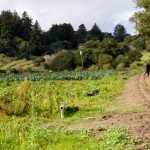 Field Walk – December 2014
Field Walk – December 2014
Take a walk with us around the farm to see the changes from the recent three days of rain.
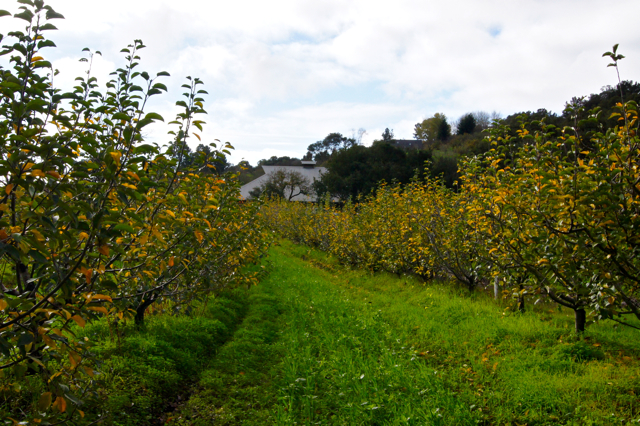
The apple trees still have some leaves, though they are yellowing as the days grow shorter. The green band in the middle of the row is a sprouting cover crop.

Farmer Juan, on the right, making his rounds. He carries a shovel with him to cut drainage ditches where there is standing water.

The near portion of the field in front of the row of corn stalks is filled with a cover crop.
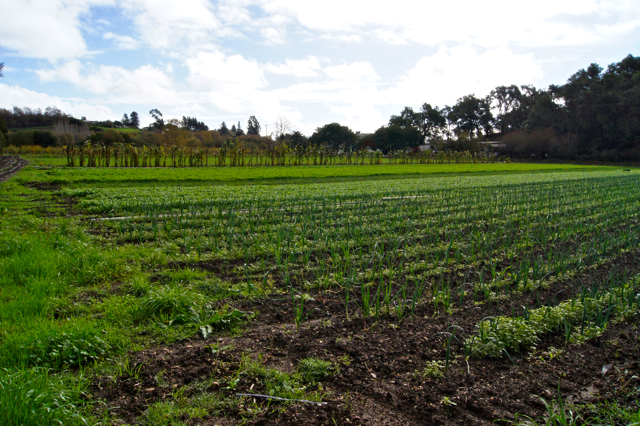
Looking from the other direction back toward the corn stalks, the near rows contain young leeks, garlic, and cilantro.
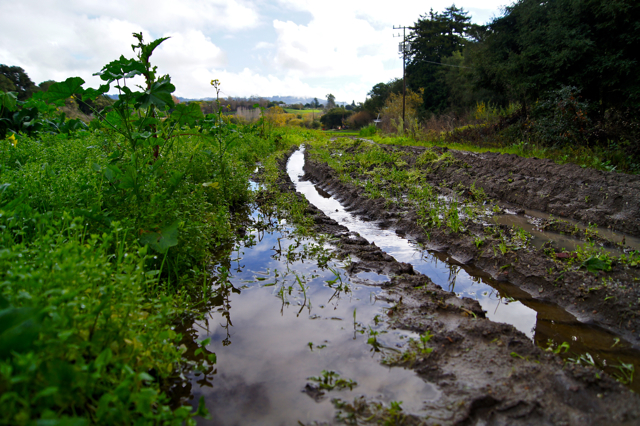
Tractors using the road create ruts that fill with rainwater. The mud created is deep, sticky, and clings to boots.
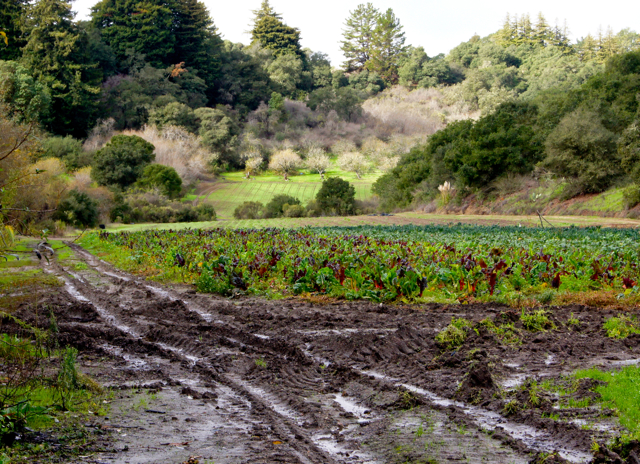
This field of chard and kale will soon be plowed then planted with a cover crop to recharge it for the next main season.
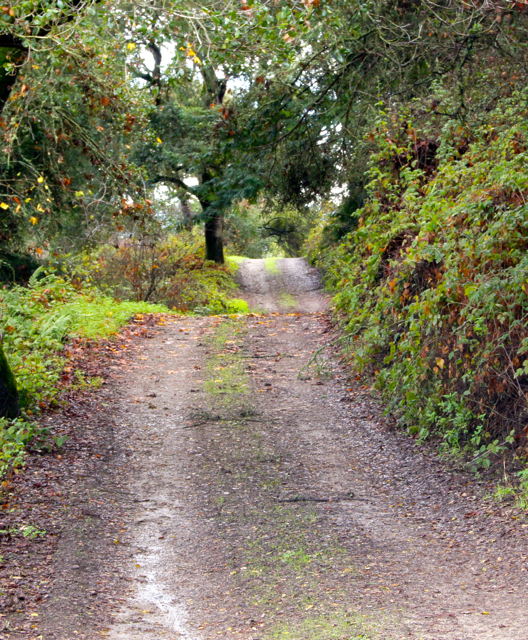
Not all the farm’s roads have standing water in them, yet they remain muddy and slippery.
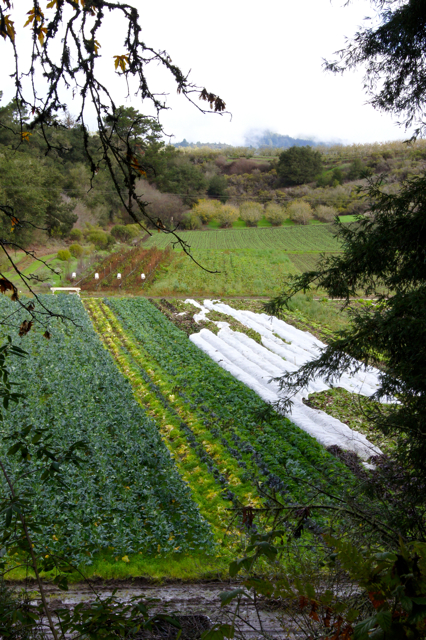
The white row covers protect fragile crops like lettuce from the worst of the rain and from future frosts.
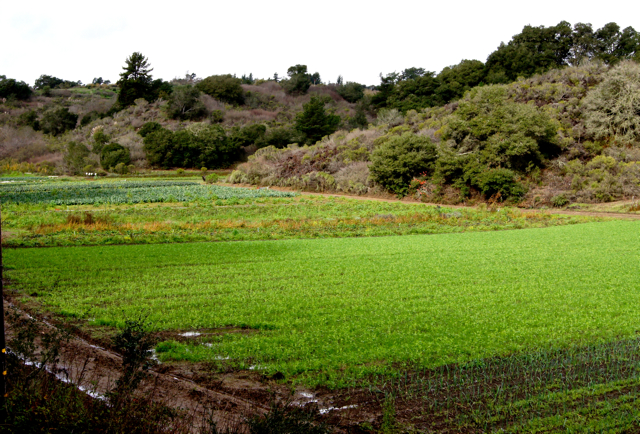
A view from the other side of the fields, with an area of cover crop in the foreground.
The season’s first rainmaker is predicted to approach the Central Coast this Friday and Saturday. Although no more than 1 inch of rain is expected to fall, it is enough to give us some drought relief. After almost six months of harvesting every single day, we are tired and dream of slowing down a bit during the hopefully rainier months ahead.

Fuji Apples ready for harvest.
With the exception of a few more rows of Fuji apples needing to be picked, our apple harvest is done for the season. Soon all the apples going into our shares (mostly our sweet Fuji’s) will be taken out of cold storage. After this next rain the strawberries and tomatoes will also officially be done, plowed back into the soil with a winter cover crop planted in the fields to rest and recharge the soil. The only fruit still being harvested for awhile longer are the pineapple guavas and, starting in December, our Meyer lemons should fully yellow to be enjoyed in our shares.

Frosty Cauliflower Field
Since crops are turning their energy inward to form seeds or store their energy in roots or trunks, winter is a good time to sow slower growing root crops that store in the ground over several months. The winter shares are a wonderful opportunity to enjoy both the nutrient dense earthy flavors of many of the root crops we grow (parsnips, celeriac, carrots, beets, and turnips), as well as the unique crisp textures and sweet flavors brassicas develop when temperatures drop into the thirties during the frostier winter nights ahead.
When the rain finally starts falling I will walk the farm to breathe a sigh of relief, surrendering to the inevitability of the more sinister decay of the farm’s crop lifecycle. The rotting windfall apples and tomatoes on the ground, I recognize, are the secret of fertility and the regenerative power of our earthly existence. I wish you all a spooky and safe Halloween!!
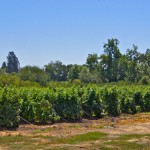 Ever Changing Fields – July 2014
Ever Changing Fields – July 2014
While some crops, like raspberry and blackberry canes, remain in the same place for a couple of years, as the season progresses most crops are rotated through the fields. Take a walk with us to see the changes.
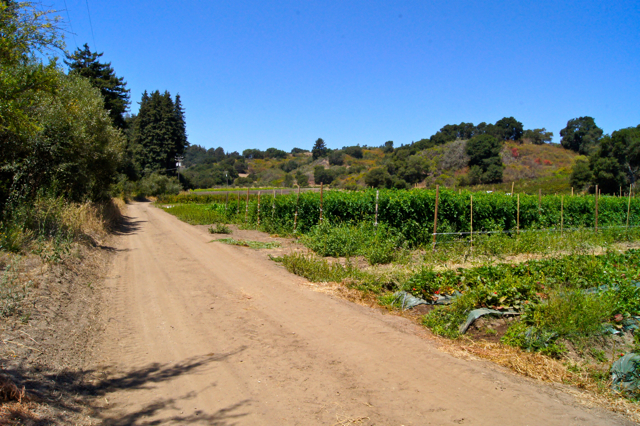
In January 2013 this portion of field was flooded, and now there are rows of raspberries and a corner of our community strawberry field.
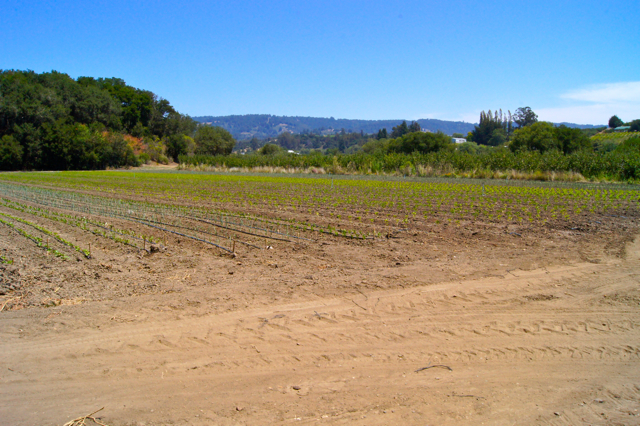
A little over two weeks ago, this field was being plowed. Now it’s full of transplants, crops that will be ready for harvest within the next month or so.
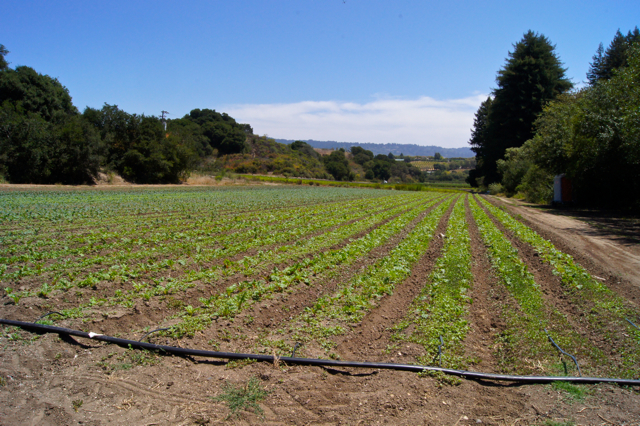
The chard in this field was transplanted about three weeks ago. Back in December, it was full of cauliflower wearing a frosty coat.
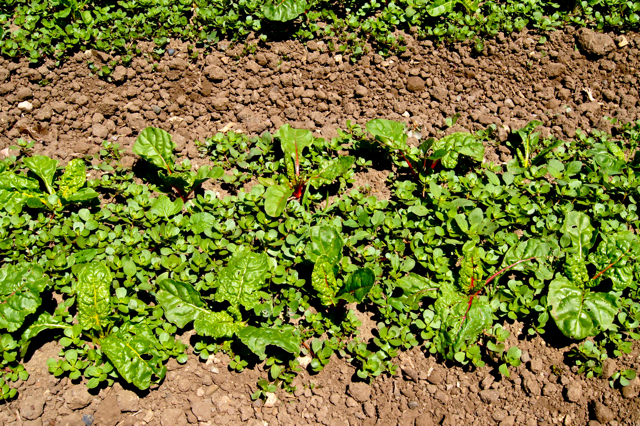
The chard has a competitor – purslane. Though edible, purslane is considered a weed and can quickly take over a field if left unchecked.
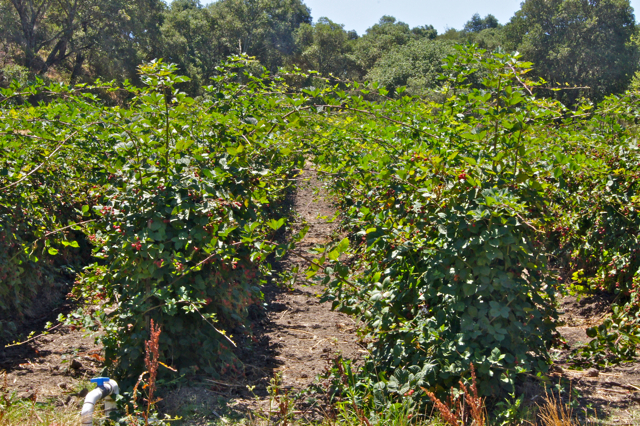
These blackberries also went through the December frost – so thick in between the rows it looked snow.
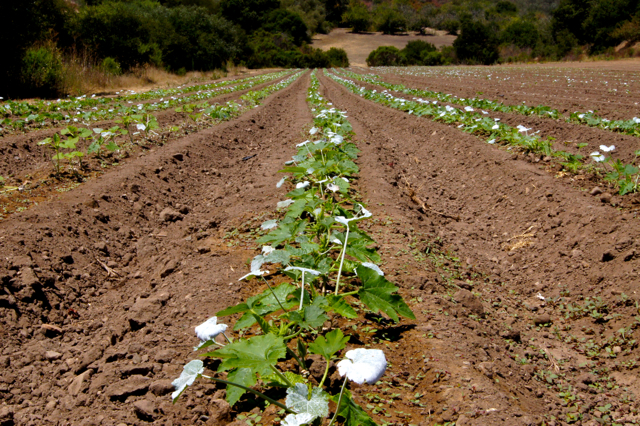
Two weeks ago this field was just freshly formed rows. Now it’s full of winter squash. The white leaves are the original ones from the transplants, dusted with clay to hinder pests like flea beetles.
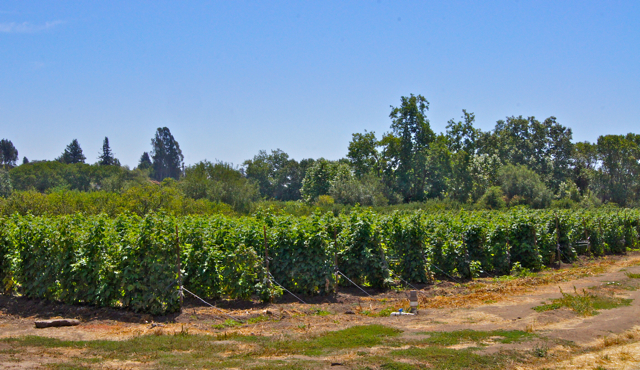
This field of first year raspberry canes was last summer’s community tomato field. And before that, in March 2013 it was full of cover crop.
Be sure to mark your calendar and join us on Saturday, August 16th for a Community Farm Day and Dry-farmed Tomato U-pick. Come take your own field walk, and enjoy the Farm!
The freedom to celebrate and express our unique individuality, our INDEPENDENCE, is closely linked to and made possible by the support and participation of a healthy community of INTERDEPENDENT members. As a farmer treating the land as a “living organism” always reminds me of that dynamic – the food we grow nourishes members in our community and is the result of an incredible diversity of functions performed by innumerable individuals – individuals all connected within Nature’s Web of Life. Happy 4thof July!
Quick Crop Update
Warm weather and long growing days have sped up the maturity of many of our crops. The Blenheim Apricot harvest, which typically starts near the end of July, was almost three weeks early and is over for this year. We picked the last ones on Tuesday, and I am so glad we were able to sneak in a Community U-pick the same day we celebrated this year’s Solstice. (Note: there will be no U-Pick on the Farm this Saturday, July 5th.) The peppers are starting to ripen, also very early. Our Farm Manager, Juan, and I tested some Padrons last week, and the first, small harvest of Yellow Wax peppers happened this week. This means dry-farmed tomatoes are just around the corner. Lots to look forward to!
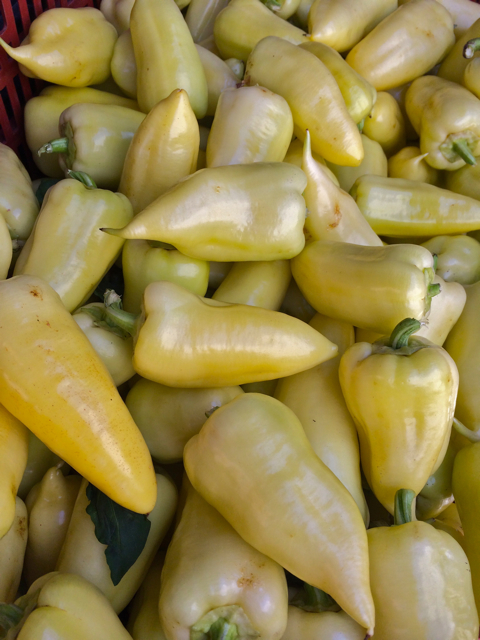
Hungarian Yellow Wax Peppers

Padron Peppers
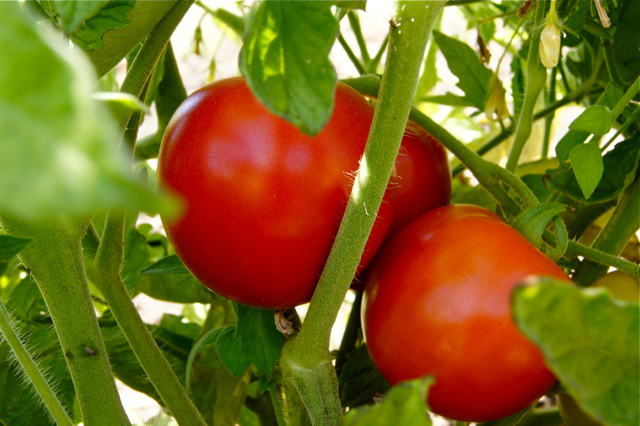
Dry-farmed Early Girl Tomatoes
 Crop & Field Notes: Frosty Fields, December 2013
Crop & Field Notes: Frosty Fields, December 2013
The past week has been a frosty one indeed. Take a walk through the fields with us to see how they look.
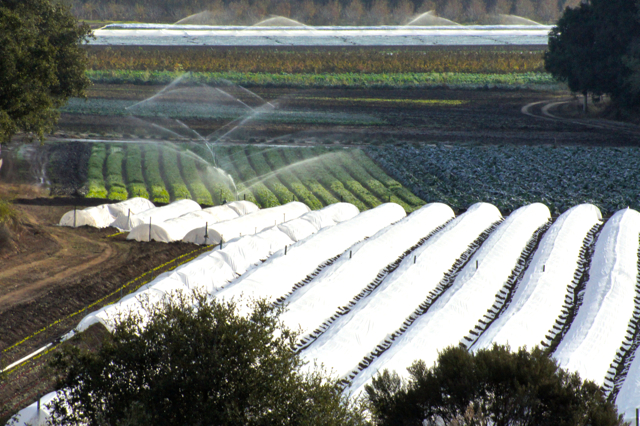
The rows in the foreground are covered in “remay” tunnels that protect crops, in this case lettuce seedlings, from frost. The rows to the right in the middle field are planted with cauliflower, while the rows on the left, being sprinkled, are planted with radishes and Japanese turnips.
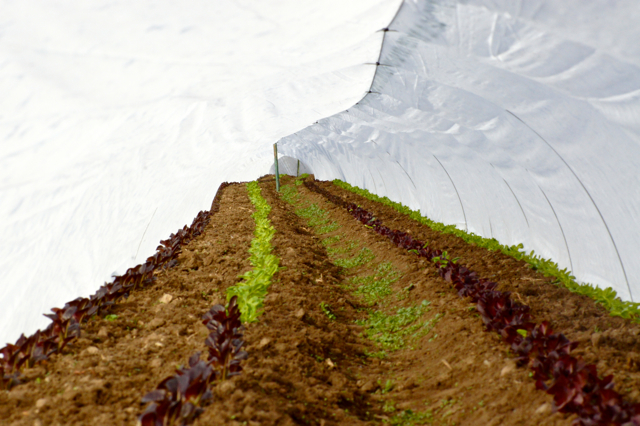
Well protected from damaging frost, the lettuce seedlings under the remay are thriving .
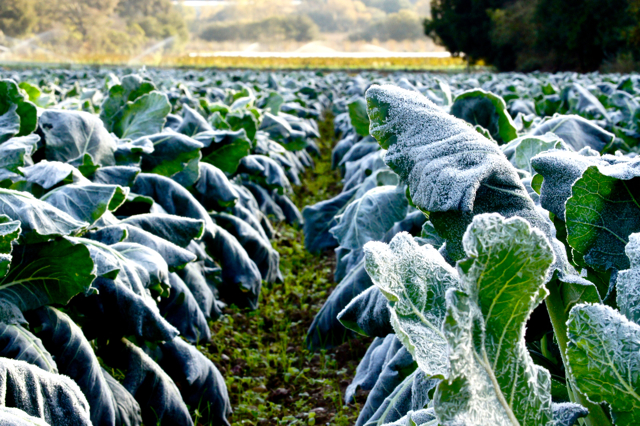
More mature cauliflower plants were sprinkled the evening before since water remaining on the leaves protects the plants by absorbing cold, creating an insulating blanket of ice crystals which keeps the plant’s temperature from falling too low.
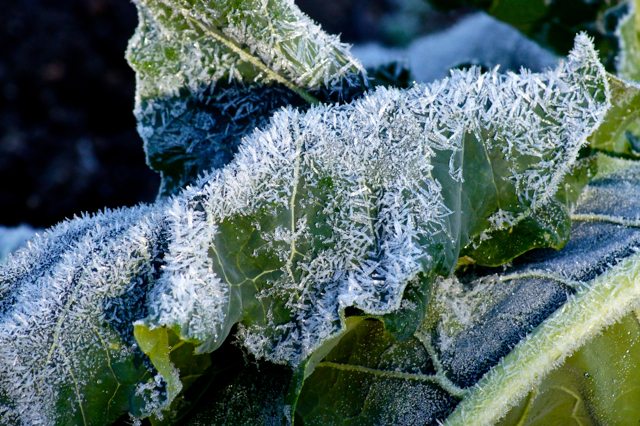
This close-up, and the one below, of the cauliflower leaves shows the patterns the frost creates.
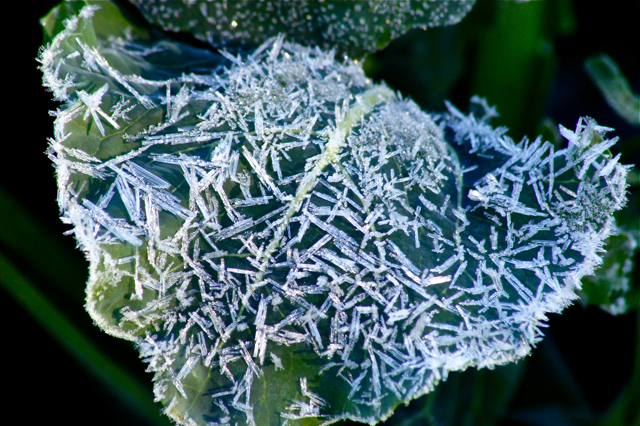
The cold weather slows growth and the plants create more sugars, which freeze at lower temps, to protect themselves. This is why winter veggies often taste sweeter than summer ones.

It got cold enough to freeze some standing water in a low patch of the road.
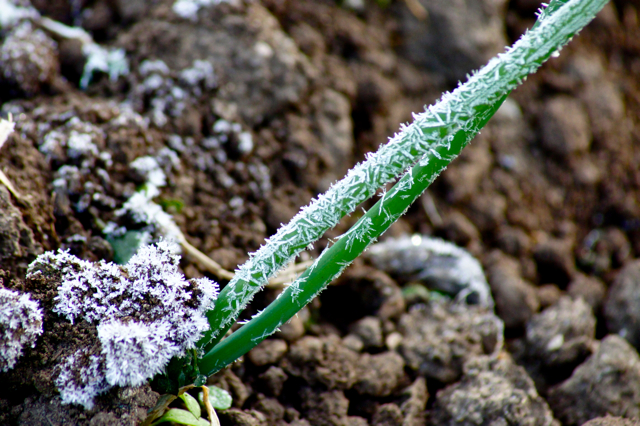
This garlic shoot is doing its best to shrug off some flakes of frost.

The frost is so thick in this blackberry row it almost looks like snow.
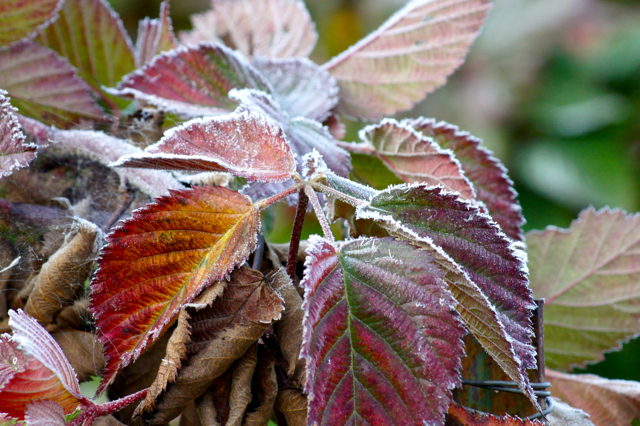
Frost rimed blackberry leaves.
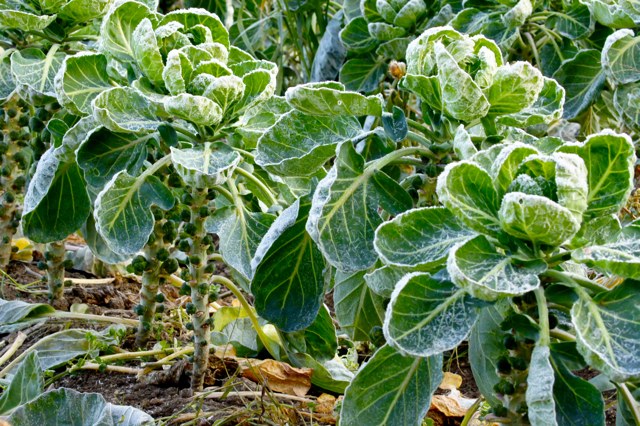
These Brussels sprouts made it through okay, and will be all the sweeter for it.
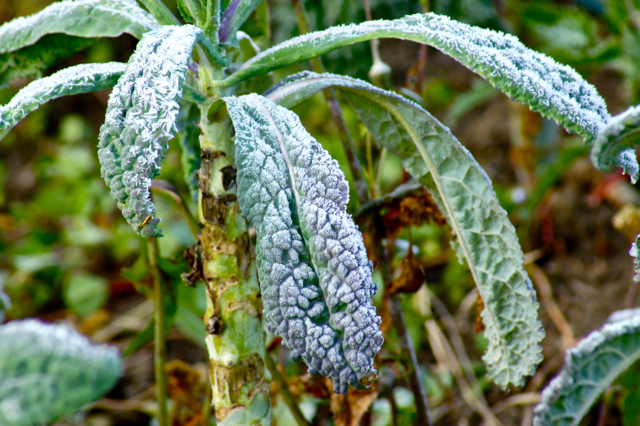
The Lacinato (Dino) Kale has its own frost blanket. Notice how the leaves have been harvested yet the plant has been left to continue to grow. The harvest is extended by leaving the plant in the ground longer.

All puffed up against the cold, this hummingbird takes a sunbath on one of the Farm’s Meyer lemon trees.
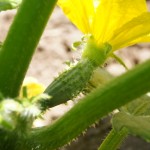 Crop & Field Notes: What’s in the Fields, August 2013
Crop & Field Notes: What’s in the Fields, August 2013
Things are always changing in the fields. From month to month, week to week, and day to day. Here’s a photo essay to keep you up to date.

Pictured here is a field of summer squash from a previous post on July 9th. It’s changed dramatically in just a few weeks.

This is the same field from the opposite direction. The squash leaves are almost completely covering the ground, and the plants are full of flowers and small squash.
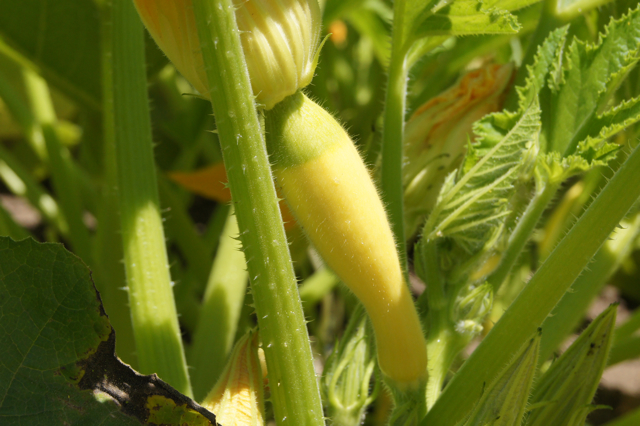
The squash are tucked in, hidden under the leaves at the base of the plants. They grow quickly, and this particular squash will be ready for harvest in just a few days

This zucchini is growing in a field nearby the one above.
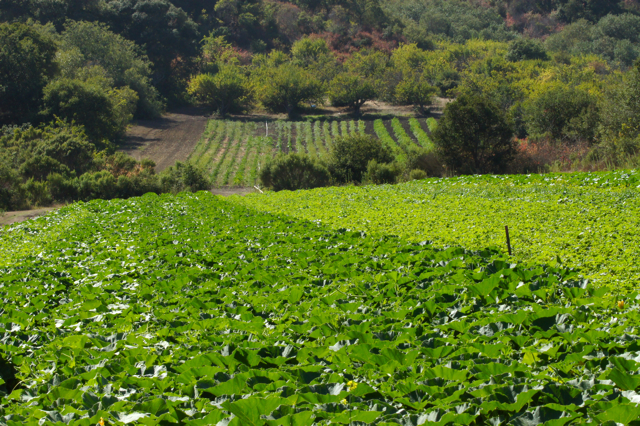
Lush and green, this is a field full of winter squash and cucumber plants.

While the winter squash are only just beginning to produce blossoms, the cucumbers are already on their way to being ready for harvest. Here’s a small pickling cucumber that will be in someone’s box soon.

The cucumber above just needs to reach this size for harvest.
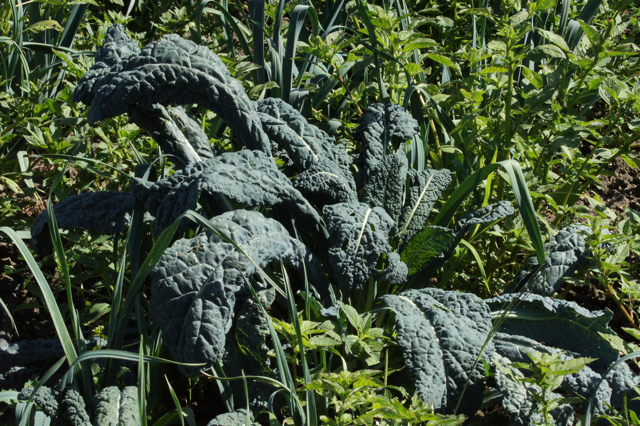
Plants have wills of their own. This dino kale, looking healthy and strong, is a volunteer that came up in the middle of a field of leeks.

Bees bees bees. We can never have enough of them here on the farm. Whether they are feeding on an invasive thistle…
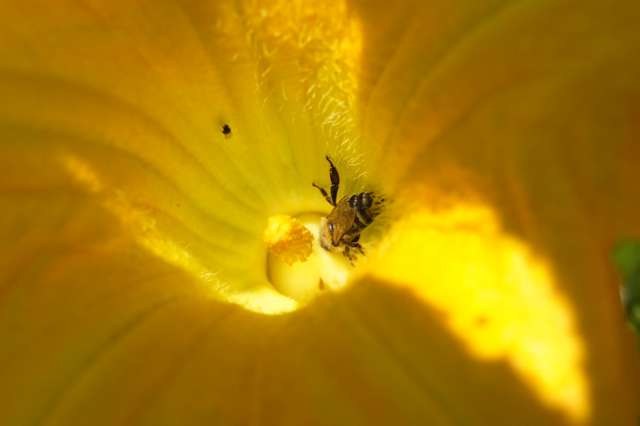
…pollinating a squash blossom…
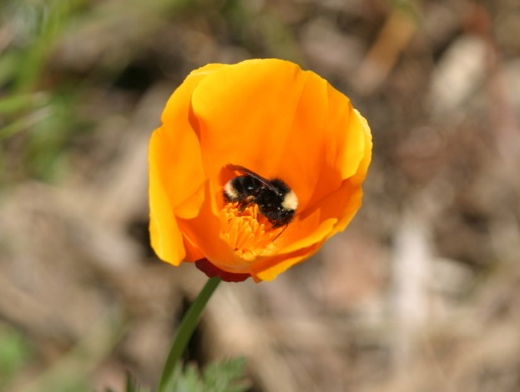
…visiting a California Poppy…

…or making sure our blackberry vines produce berries, we love them.
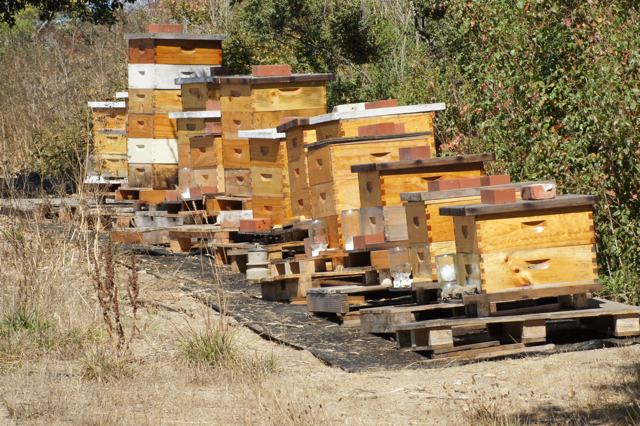
In fact, there are now some permanent hives on the farm. These were placed here, and are managed by, friend-of-the-farm Patrick W.

Summer is a colorful time on the farm. Even the poison oak puts on its red dress.

Much preferred, though, is the red of our dry-farmed Early Girl tomatoes. Are you ready for the U-Harvest on Saturday, Aug 24th?

While the Early Girls are already being put in the shares, with the August heat upon us it won’t be long before these Heirloom tomatoes will be ready for harvest, too.

In contrast to last year, this season has been a good one for our cane berries. Recently harvested, this blackberry row still has lots of ripening berries.
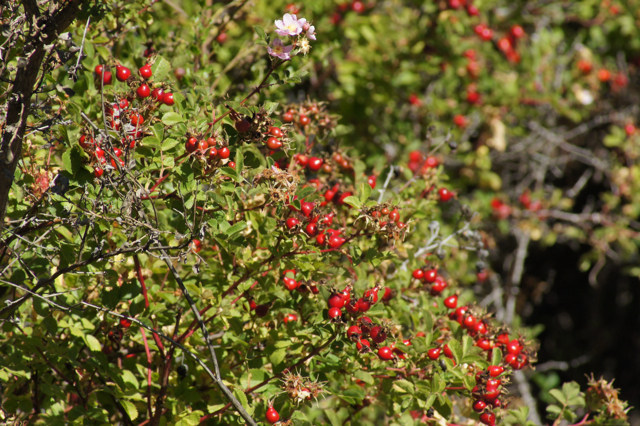
There are many patches of wild roses on the farm. This time of year, wild rose hips are adding their own bit of red to the landscape. Cup of tea anyone?
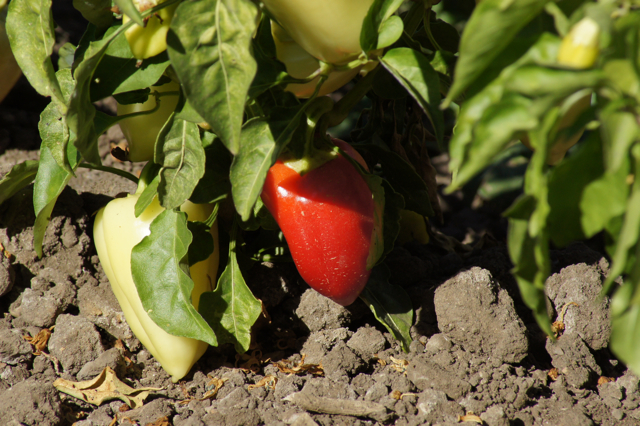
Sweet Lipstick Peppers peek out from under leaves in the pepper fields.
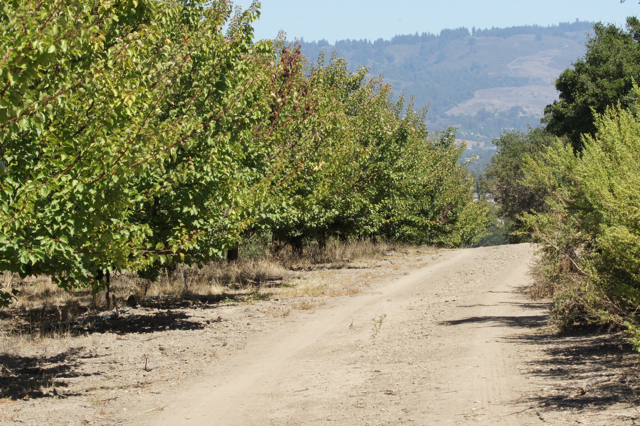
Though the apricot trees no longer have any fruit on them…

…they still bear small jewels. Protective sap balls form where a branch’s bark cracked or sustained some kind of damage.

Our Concord grape vines have been quietly working away…

…creating jewels of their own that will be ready for harvest in late September.
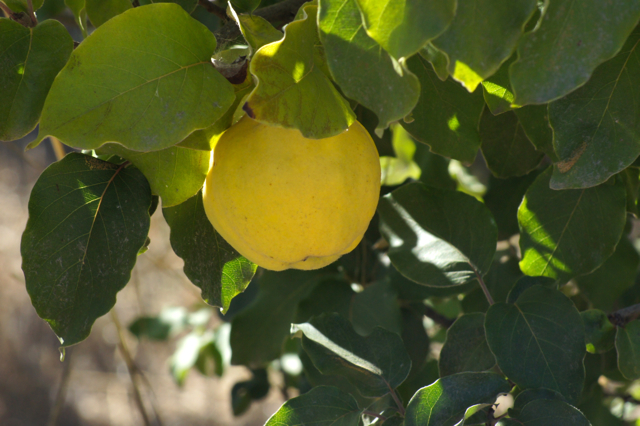
An obscure fruit, the quince are just starting to turn yellow and give off their wonderful fragrance. Difficult to use, these don’t appear in the shares very often, instead they go to Happy Girl Kitchen to be turned into quince candy and membrillo.
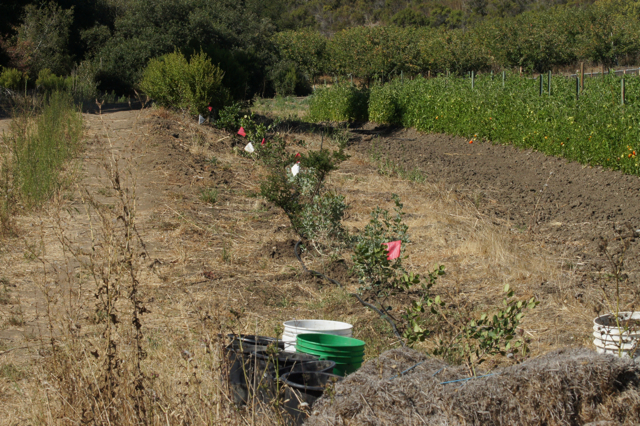
There are a number of hedgerow projects on the farm. This row was recently planted near the Heirloom tomato field.
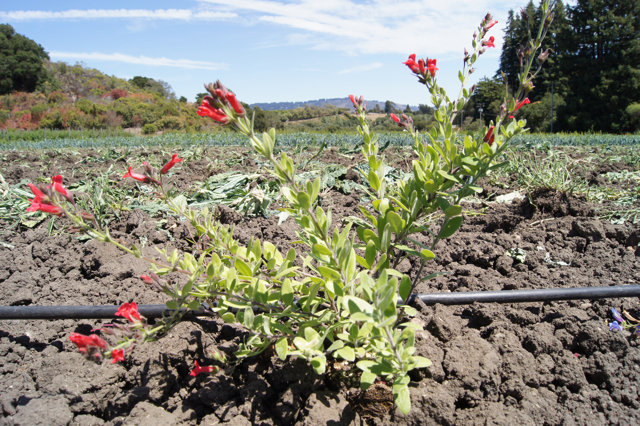
The hedgerows contain native plants, like this penstemon…
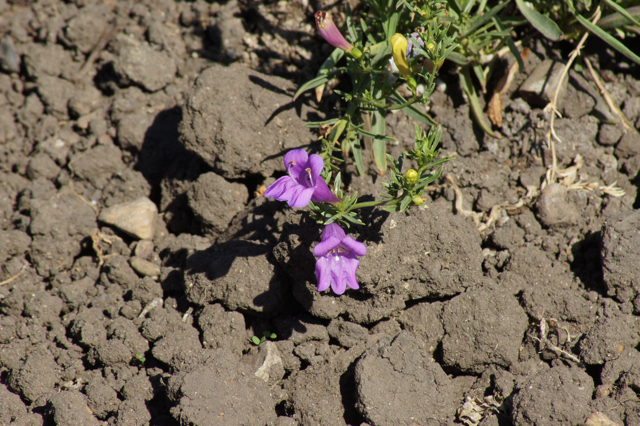
…and this other variety of penstemon, too. Their flowers are important attractors for pollinators.
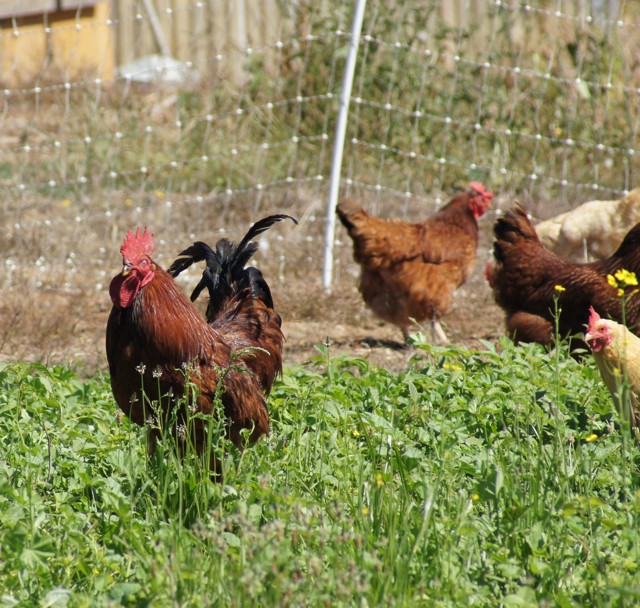
What would a farm be without animals and other wildlife. This rooster is in with one of our pastured flocks. Though hens will lay eggs without a rooster, having one can help since they announce intruders, herd or lead the hens into the coop at dusk, and dole out any tasty morsels as evenly and fairly as possible (at least, a good rooster does so).

This is one of the goat kids born earlier this year. The kids are growing fast, and they’ve already become noisy teens bleating “hello, don’t you want to feed me?” as anyone walks past their enclosure.

Our farm dog, Chella, takes it easy in the shade on a hot day. She’ll be up all night chasing away coyotes from the hens and deer from the fields, so she deserves a good rest.
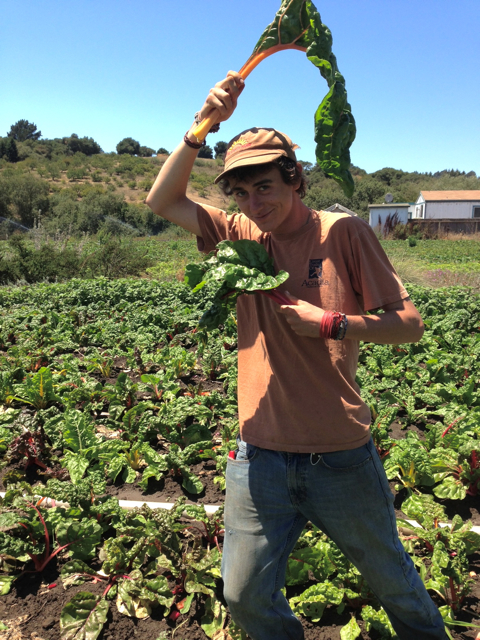
And speaking of wildlife, here’s one of our summer helpers, Noah, flying his chard flag high while doing his happy chard-dance.
Summer is a great time to visit the farm, so come on by on a Saturday to shop at our Green Valley Barn Farm Stand, walk the fields and nibble on some freshly picked produce, and take in the sights and scents.
 Dry-farmed Tomato U-Harvest Day – Aug 24th, 2013
Dry-farmed Tomato U-Harvest Day – Aug 24th, 2013
The pictures below express more about the fun we had last Saturday at our first Dry-farmed Tomato U-Harvest than words ever will – thank you all so much for joining us on the farm!! 🙂
Due to the high demand and interest by members and extended community, we will continue hosting Saturday Tomato U-Harvests for the next two weeks, Saturday, August 31 and Saturday, September 7 from 10:00AM – 3:00PM. (Click here for more information).
